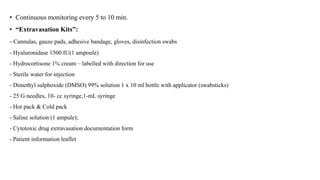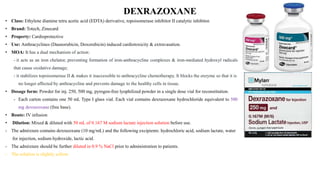The document discusses the issue of extravasation, which is the unintentional leakage of chemotherapy drugs from intravenous sites into surrounding tissues, potentially leading to significant damage. It outlines the incidence rates, risk factors, classifications of drugs based on their effects on tissue, and the signs and symptoms indicative of extravasation. The document further details diagnostic approaches, treatment options, and specific antidotes for managing such events, highlighting substances like dimethyl sulfoxide, dexrazoxane, and others.






























![CENTRAL VENOUS ACCESS DEVICE (CVAD) EXTRAVASATION
• Extravasation of chemotherapy agents administered through a CVAD is a rare complication.
• In this situation, the solution may accumulate in the mediastinum, pleura or in a subcutaneous area of the chest or neck.
• The most frequent symptom of central line extravasation is acute thoracic pain.
• Diagnosis must be based on clinical presentation and confirmed with imaging techniques, usually a thoracic CT scan [V, A].
• Data about management and evolution are based on case reports.
• The management of this infrequent extravasation should include stopping of the infusion and aspiration through the
central venous catheter of as much amount of the solution as possible.
• If the extravasated agent is an anthracycline, dexrazoxane might be considered as an antidote [V, C].
• Conservative therapy (surgical procedures with the objective of draining the remaining solution might be considered) [V, C].
• Antibiotics, i.v. corticoids, analgesia and other treatments leading to the control of the symptoms derived from the
mediastinitis or pleuritis secondary to extravasation can be considered [V, B]](https://image.slidesharecdn.com/extravasation-240517181617-c17c140f/85/Case-Presentation-Extravasation-pptx-Onco-31-320.jpg)






